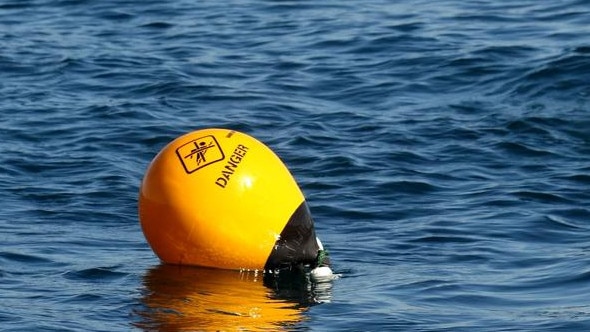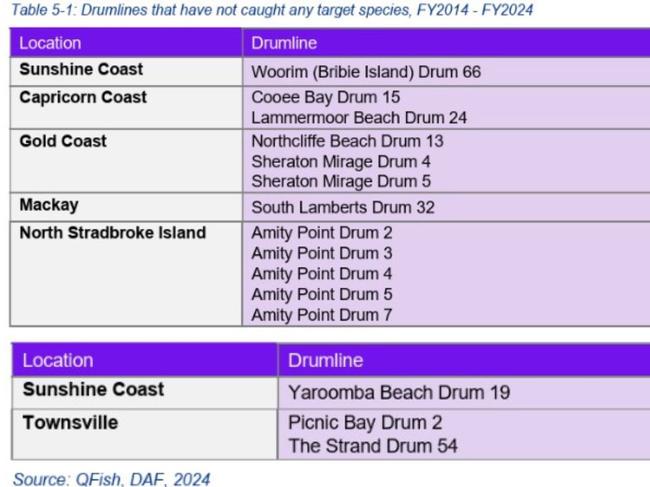Locals, scientists slam expanding shark control efforts
Queensland’s $88 million shark control revamp has ignited backlash from North Stradbroke Island, where residents say the measures are damaging marine ecosystems.

QLD News
Don't miss out on the headlines from QLD News. Followed categories will be added to My News.
A major shake-up of Queensland’s Shark Control Program has alarmed North Stradbroke Island residents, who fear it will harm marine life and hurt eco-tourism.
Primary Industries Minister Tony Perrett last week announced an $88 million plan as the largest investment in shark management in the state’s history.
It includes year-round servicing of drumlines, broader drone surveillance, and more funding for the whale-deterrent “pinger” technology.

Seven beaches are earmarked for potential new nets and drumlines, including Elliott Heads, Moore Park, and Pacific Beach on the Gold Coast. Cylinder Beach on Stradbroke and Tangalooma in Moreton Bay are among six others being considered for drone upgrades.
Despite its scale, the plan has drawn fierce backlash from conservationists, scientists, and locals.
Critics argued the use of lethal drumlines may breach federal law, and warn it will increase bycatch without significantly improving swimmer safety.
That anger deepened after the sudden resignation of leading shark researcher Professor Colin Simpfendorfer from an advisory role with the program.
He declined to comment.
Mr Perrett defended the changes, due to begin in July as humpback whales migrate north through Moreton Bay, saying they “strike the right balance” between human safety and environmental protection.
He said the program had “lost its way under previous governments”.
But for many Stradbroke residents, that balance is off.
QFish data from the Department of Agriculture and Fisheries showed five drumlines off Amity Point on Stradbroke hadn’t caught a single target shark in the past decade.
Despite that, the government said on Sunday it would continue to push ahead with the expanded controls.
Long-time island resident Ross Watts called the plan “a political solution to a media problem”.
“It won’t make swimmers safer, but it will cost more whales and turtles their lives,” he said.
Drone technology has also failed to win over islanders.
Although a drone is stationed at Cylinder Beach and has helped evacuate swimmers after shark sightings, coverage is limited to weekends and school holidays and often disrupted by weather.
Patrols are aligned with Surf Lifesaving Queensland schedules, which resulted in the exclusion of Bribie Island, which did not have patrols outside peak periods.
Resident Mel Downey said the drones were promising but don’t remove lethal methods.
“The government should be investing in nonlethal shark barriers and science-based deterrents, not 1950s drum line technology that kills dugongs and dolphins,” he said.
Long-time island resident Liz Johnston said a 2017 Senate Inquiry made it clear nets and drumlines did not make beaches safer.
“They cause serious harm and lull swimmers into a false sense of security and last year, there were no fatal attacks, and yet hundreds of marine animals died unnecessarily,” she said.
“If these whale pinger deterrents drive whales away from drumlines and nets will that affect our whalewatching industry in Minjerribah?”
She said 16 of the 19 shark species targeted by the program posed little or no threat to humans.
A KPMG report finalised last month found shark bites had declined from 3.35 a year to just over one but bycatch had worsened.
Between 2021 and 2024, 1200 marine animals died in the program, with average bycatch deaths rising to 362 a year.
A trial using “circle hooks”, which reduce injury by hooking sharks in the jaw, will also be part of the program underway at 16 beaches, including Straddie.
But for many, the reforms still don’t go far enough to protect marine ecosystems.
More Coverage
Originally published as Locals, scientists slam expanding shark control efforts





